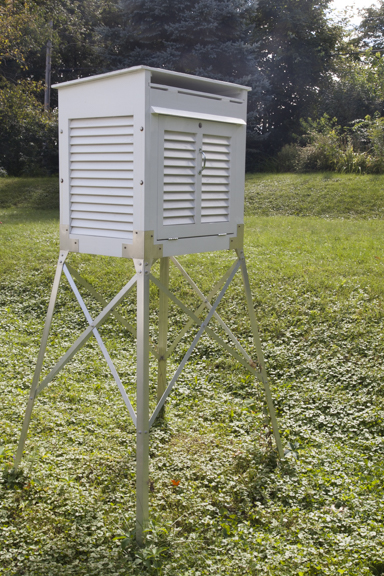Cotton Region Shelter
/Cotton Region Shelter - Photo by Craig Johnson
The Cotton Region Shelter is an American adaptation of the original Stevenson Screen which was developed by Thomas Stevenson in 1864. Stevenson was a civil engineer and, incidentally, the father of author Robert Louis Stevenson. Stevenson's small screen (shelter) was modified by Edward Mawley and adapted by the Royal Meteorological Society in 1884. Stevenson's design included double louvered sides all around.
The American adaptation, called the Cotton Region Shelter, houses thermometers (standard as well as maximum and minimum), a psychrometer or other device to read dew point and relative humidity, and recording thermometers, hygrometers and barometers. The purpose of the shelter is to shield the instrumentation from direct sunlight and precipitation, while allowing a free flow of air. If sunlight shines directly on the sensors the readings will be too high.
Interior of Cotton Region Shelter - Photo by Craig Johnson
The shelter pictured above meets official National Weather Service standards. Inside are the following instruments; left to right:
- Transmitter and sensors for remote display of temperature and relative humidity (far left)
- standard mercury in glass thermometer
- maximum - minimum thermometers on a Townsend Support
- a hygrometer
- sling psychrometer to measure wet-bulb temperature and determine relative humidity and dew point (far right)
- On the floor of the shelter near the sling psychrometer is a jar with water for the sling psychrometer
The shelter is used for hobby purposes. The standard thermometer and max-min thermometers and sling psychrometer are scientific grade instruments. The dial hygrometer (right corner) and the transmitter and sensors (far left) are consumer grade accuracy. Records are kept using the scientific grade instruments. The front door to the shelter faces north and is opened only when the instruments need to be read. Notice the instruments are kept in the shade by the shelter.
The Cotton Region Shelter has been largely replaced for official measurements in the United States by the MMTS (maximum-minimum temperature system) system. The MMTS began replacing cotton region shelters in the 1980s to eliminate liquid-in-glass thermometers that contained mercury. They were more convenient because readings could be read and reset indoors and the aspirated (ventilated by a fan) shelters with MMTS were more accurate. Today the Cotton Region Shelter is still used by many cooperative NWS weather stations and and still may be purchased. Prior to the 1980s the Cotton Region Shelters were the standard shelters in the United States.
MMTS Shelter - Photo Courtesy of NOAA
The MMTS shelter is aspirated which means air is pulled through the shelter by a ventilation system. This improves the accuracy of the readings. Large objects such as trees, tall bushes, buildings interrupt the flow of air around shelters and can affect the readings of both MMTS and Cotton Region Shelters.
Minimum Thermometer inside a Cotton Region Shelter - Photo by Craig Johnson
The close-up photo above shows the alcohol filled minimum liquid-in-glass thermometer. The black index marks the low point of the temperature since the last reset. The low temperature is read at the right end of the index. The thermometer is reset by tipping the thermometer clockwise allowing the index to slide down to the top of the alcohol. Surface tension of the alcohol stops the sliding index at the current temperature. As the temperature increases the alcohol flows around the index as it expands to the right leaving the index in place where it was reset. When the temperature decreases the alcohol contracts to the left. When it contacts the right end of the index the alcohol drags the index to the left. The alcohol can drag the index to the left but it cannot move the index to the right as the alcohol expands.





